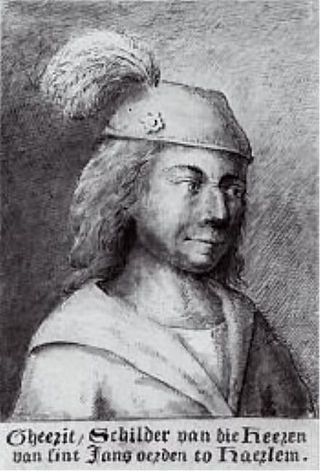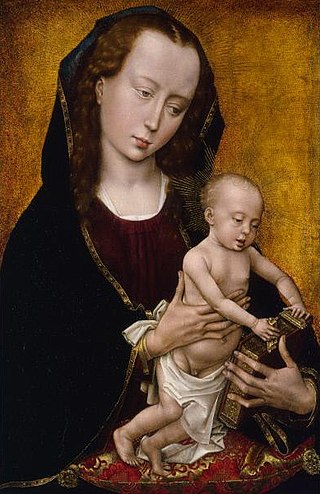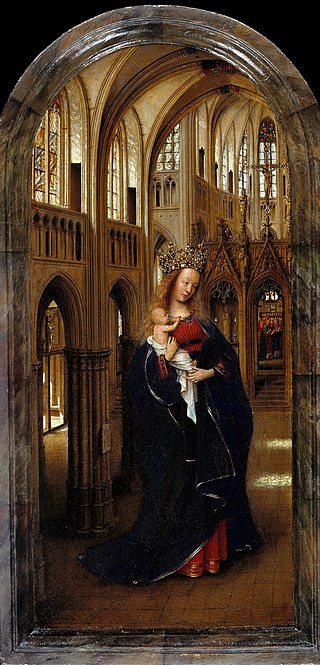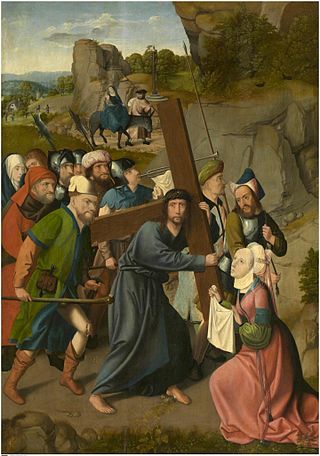
The Master of the Brunswick Diptych (fl. c. 1480-1510) was a Dutch early Renaissance painter.

The Master of the Brunswick Diptych (fl. c. 1480-1510) was a Dutch early Renaissance painter.
Nothing is known for certain about the anonymous master. Some scholars have attempted to identify the artist as Jacob van Haarlem, who is documented as having lived and worked in Haarlem from 1483 to 1509 and may have been a teacher to Jan Mostaert, but this remains a speculation. [1]
The anonymous master is named after a diptych in Brunswick, depicting Mary with an infant Jesus, Saint Anne and, opposite, a kneeling Carthusian monk and Saint Barbara. From this work, a number of other paintings have been identified as being by the same hand. [1]
The works by the Master of the Brunswick Diptych show similarities with those of Geertgen tot Sint Jans, such as the Rijksmuseum nativity, but the colours are generally lighter, his treatment of space and anatomy is less accomplished and the paintings more miniature-like. In a panel painting presently in Cologne, the master breaks new ground by depicting a domestic scene of a woman feeding a child for the first time in panel painting. [1]

A polyptych is a painting which is divided into sections, or panels. Specifically, a "diptych" is a two-part work of art; a "triptych" is a three-part work; a tetraptych or quadriptych has four parts, whereas a polyptych describes any work of art formed of more than one constitutive part.

Adriaen Isenbrandt or Adriaen Ysenbrandt was a painter in Bruges, in the final years of Early Netherlandish painting, and the first of the Dutch and Flemish Renaissance painting of the Northern Renaissance. Documentary evidence suggests he was a significant and successful artist of his period, even though no specific works by his hand are clearly documented. Art historians have conjectured that he operated a large workshop specializing in religious subjects and devotional paintings, which were executed in a conservative style in the tradition of the Early Netherlandish painting of the previous century. By his time, the new booming economy of Antwerp had made this the centre of painting in the Low Countries, but the previous centre of Bruges retained considerable prestige.

JeanFouquet was a French painter and miniaturist. A master of panel painting and manuscript illumination, and the apparent inventor of the portrait miniature, he is considered one of the most important painters from the period between the late Gothic and early Renaissance. He was the first French artist to travel to Italy and experience first-hand the early Italian Renaissance.

Bernard van Orley, also called Barend or Barent van Orley, Bernaert van Orley or Barend van Brussel, was a versatile Flemish artist and representative of Dutch and Flemish Renaissance painting, who was equally active as a designer of tapestries and, at the end of his life, stained glass. Although he never visited Italy, he belongs to the group of Italianizing Flemish painters called the Romanists, who were influenced by Italian Renaissance painting, in his case especially by Raphael.

Early Netherlandish painting is the body of work by artists active in the Burgundian and Habsburg Netherlands during the 15th- and 16th-century Northern Renaissance period, once known as the Flemish Primitives. It flourished especially in the cities of Bruges, Ghent, Mechelen, Leuven, Tournai and Brussels, all in present-day Belgium. The period begins approximately with Robert Campin and Jan van Eyck in the 1420s and lasts at least until the death of Gerard David in 1523, although many scholars extend it to the start of the Dutch Revolt in 1566 or 1568–Max J. Friedländer's acclaimed surveys run through Pieter Bruegel the Elder. Early Netherlandish painting coincides with the Early and High Italian Renaissance, but the early period is seen as an independent artistic evolution, separate from the Renaissance humanism that characterised developments in Italy. Beginning in the 1490s, as increasing numbers of Netherlandish and other Northern painters traveled to Italy, Renaissance ideals and painting styles were incorporated into northern painting. As a result, Early Netherlandish painters are often categorised as belonging to both the Northern Renaissance and the Late or International Gothic.

Geertgen tot Sint Jans, also known as Geertgen van Haarlem, Gerrit van Haarlem, Gerrit Gerritsz, Gheertgen, Geerrit, Gheerrit, or any other diminutive form of Gerald, was an Early Netherlandish painter from the northern Low Countries in the Holy Roman Empire. No contemporary documentation of his life has been traced, and the earliest published account of his life and work is from 1604, in Karel van Mander's Schilder-boeck.

Jan Mostaert was a Dutch Renaissance painter who is known mainly for his religious subjects and portraits. One of his most famous creations was the Landscape with an Episode from the Conquest of America.

Antwerp Mannerism is the name given to the style of a group of largely anonymous painters active in the Southern Netherlands and principally in Antwerp in roughly the first three decades of the 16th century, a movement marking the tail end of Early Netherlandish painting, and an early phase within Dutch and Flemish Renaissance painting. The style bore no relation to Italian Mannerism, which it mostly predates by a few years, but the name suggests that it was a reaction to the "classic" style of the earlier Flemish painters, just as the Italian Mannerists were reacting to, or trying to go beyond, the classicism of High Renaissance art.

The Melun Diptych is a two-panel oil painting by the French court painter Jean Fouquet created around 1452. The name of this diptych came from its original home in the Collegiate Church of Notre-Dame in Melun. The left panel depicts Étienne Chevalier with his patron saint St. Stephen and the right panel depicts the Virgin and Christ child surrounded by cherubim. Each wooden panel measures about 93 by 85 centimeters and the two would have been hinged together at the center.

A donor portrait or votive portrait is a portrait in a larger painting or other work showing the person who commissioned and paid for the image, or a member of his, or her, family. Donor portrait usually refers to the portrait or portraits of donors alone, as a section of a larger work, whereas votive portrait may often refer to a whole work of art intended as an ex-voto, including for example a Madonna, especially if the donor is very prominent. The terms are not used very consistently by art historians, as Angela Marisol Roberts points out, and may also be used for smaller religious subjects that were probably made to be retained by the commissioner rather than donated to a church.

The Diptych of Philip de Croÿ with The Virgin and Child consists of a pair of small oil-on-oak panels painted c. 1460 by the Netherlandish artist Rogier van der Weyden. While the authorship and dating of both works are not in doubt, it is believed but not proven that they were created as wings of a devotional diptych and that at some unknown time the panels were broken apart. A diptych panel fitting the description of the Mary wing was described in a 1629 inventory of paintings owned by Alexandre d'Arenberg, a descendant of Philip I de Croÿ (1435–1511). Both have been approximately dated to 1460 and are now in Antwerp and San Marino, CA respectively. The reverse of de Croÿ's portrait is inscribed with the family crest and the title used by the sitter from 1454 to 1461.

Crucifixion Diptych — also known as Philadelphia Diptych, Calvary Diptych, Christ on the Cross with the Virgin and St. John, or The Crucifixion with the Virgin and Saint John the Evangelist Mourning — is a diptych by the Early Netherlandish artist Rogier van der Weyden, completed c. 1460, today in the Philadelphia Museum of Art. The panels are noted for their technical skill, visceral impact and for possessing a physicality and directness unusual for Netherlandish art of the time. The Philadelphia Museum of Art describes work as the "greatest Old Master painting in the Museum."

Madonna in the Church is a small oil panel by the early Netherlandish painter Jan van Eyck. Probably executed between c. 1438–1440, it depicts the Virgin Mary holding the Child Jesus in a Gothic cathedral. Mary is presented as Queen of Heaven wearing a jewel-studded crown, cradling a playful child Christ who gazes at her and grips the neckline of her red dress in a manner that recalls the 13th-century Byzantine tradition of the Eleusa icon. Tracery in the arch at the rear of the nave contains wooden carvings depicting episodes from Mary's life, while a faux bois sculpture in a niche shows her holding the child in a similar pose. Erwin Panofsky sees the painting composed as if the main figures in the panel are intended to be the sculptures come to life. In a doorway to the right, two angels sing psalms from a hymn book. Like other Byzantine depictions of the Madonna, van Eyck depicts a monumental Mary, unrealistically large compared to her surroundings. The panel contains closely observed beams of light flooding through the cathedral's windows. It illuminates the interior before culminating in two pools on the floor. The light has symbolic significance, alluding simultaneously to Mary's virginal purity and God's ethereal presence.

The Crucifixion and Last Judgement diptych consists of two small painted panels attributed to the Early Netherlandish artist Jan van Eyck, with areas finished by unidentified followers or members of his workshop. This diptych is one of the early Northern Renaissance oil-on-panel masterpieces, renowned for its unusually complex and highly detailed iconography, and for the technical skill evident in its completion. It was executed in a miniature format; the panels are just 56.5 cm (22.2 in) high by 19.7 cm (7.8 in) wide. The diptych was probably commissioned for private devotion.

Man of Sorrows is a small Early Netherlandish oil on wood panel painting completed c. 1485–1495. It is attributed to Geertgen tot Sint Jans and in the tradition of the devotional images of the "Man of Sorrows", which typically show Christ before his crucifixion, naked above the waist, bearing the wounds of his Passion. The panel has an unusually complex and suffocating spatial design, and depicts the mocking of Jesus, and his grieving mother. The panel is steeped in both complex iconography and deep pathos. Christ is in obvious pain and holds his wounds up for the viewer. He looks out while white robed weeping angels bear the Arma Christi -objects associated with his crucifixion and death- float around him. The attending saints include Mary and the Magdalene.

The Master of Hoogstraeten is the Notname given to a Flemish painter or a collective of painters active in Antwerp in the early 16th century. The master created principally religious paintings and is considered a member of the Antwerp Mannerists.

The Holy Kinship is a circa 1495 oil on panel painting of Holy Kinship by the workshop of the renaissance artist Geertgen tot Sint Jans in the collection of the Rijksmuseum.

Maria Magdalene is a circa 1530 oil on panel painting by the Dutch renaissance artist Jan van Scorel in the collection of the Rijksmuseum.

Adriaen van Overbeke, Adrian van Overbeck and Adriaen van Overbeke was a Flemish Renaissance painter in the style of Antwerp Mannerism. He operated a large workshop with an important output of altarpieces, which were mainly exported to Northern France, the Rhineland and Westphalia. His known works were predominantly polychromed wooden altarpieces with painted shutters, which were created through a collaboration between painters and sculptors.

The Mocking of Christ is a small 13th-century panel painting by the Italian artist Cimabue, in tempera on a poplar panel. It depicts the mocking of Jesus and is one of three panels known from Cimabue's Diptych of Devotion. It was discovered in the kitchen of an elderly woman in northern France. In October 2019 it sold at auction for €24 million, a record for an artwork predating the 16th century. It is believed to be the first work by Cimabue to have been auctioned. Following an export ban, it was acquired by the Louvre in 2023.